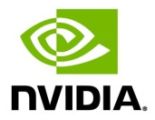SAN JOSE, CA — (Marketwire) — 03/19/13 — — Top enterprise and mobile application companies are using GPUs to tackle big data analytics and advanced search for both consumer and commercial applications, NVIDIA today announced.
Shazam, Salesforce.com and Cortexica are at the forefront of companies expanding the use of GPUs beyond their traditional role of processing massive data sets and complex algorithms for high performance computing science and engineering applications. They rely on for areas as diverse as audio search, big data analytics and image recognition.
“GPU accelerators provide great value to applications with lots of data or computations,” said Sumit Gupta, general manager of the Tesla accelerated computing business at NVIDIA. “A growing number of applications that provide mobile service and social media analysis have both. And that-s prompting their providers to turn to GPU accelerators as they scale up their infrastructure to meet growing demand.”
Shazam — one of the top five music applications in the Apple App Store and Google Play store — uses GPU accelerators to rapidly search and identify songs from its 27 million track database. Using a mobile phone or tablet, the app-s 300 million-plus users capture brief samples of music, which are then matched with an acoustic fingerprint.
With more than 10 million song searches a day, 2 million new users joining the service every week and its database having doubled over the last year, Shazam is growing rapidly. By accelerating the search and matching process, Tesla GPUs enable Shazam to maintain a low-cost server infrastructure that scales with the company-s dramatic growth.
“GPUs enable us to handle our tremendous processing needs at a substantial cost savings, delivering twice the performance per dollar compared to a CPU-based system,” said Jason Titus, chief technology officer of Shazam Entertainment. “We are adding millions of video and foreign language audio tracks to our existing services, and GPU accelerators give us a way to achieve scalable growth.”
Salesforce.com uses GPU accelerators to help major international brands, including Cisco, Dell and Gatorade, monitor and analyze more than 500 million daily tweets for brand, product, and service and support issues.
NVIDIA CUDA® GPUs enable Salesforce.com to deliver insights almost 10 minutes faster than with a comparable CPU-based system. In addition, GPUs provide enough headroom for the company to scale with the exponential growth of Twitter and the increasing demand for advanced social media by business customers.
Cortexica-s mobile application makes it effortless for consumers to find and purchase goods they like. Consumers can photograph shirts or similar items using their mobile phones or tablets, and the app searches through an online database of apparel to instantly find matches available for purchase from online retailers.
With GPU accelerators, Cortexica can run complex visual object recognition algorithms on a modest amount of server hardware to enable real-time searches against a database of millions of images.
“GPUs are fundamental to our success,” said Iain McCready, chief executive officer at Cortexica. “GPU accelerators run our complex bio-inspired algorithms 30 times faster than CPUs, giving our users the best, fastest and most accurate consumer experience.”
More information about NVIDIA Tesla GPUs is available at the . To learn more about the CUDA parallel programming model or download the latest version of the C/C++ toolkits, visit the .
Since 1993, (NASDAQ: NVDA) has pioneered the art and science of visual computing. The company-s technologies are transforming a world of displays into a world of interactive discovery — for everyone from gamers to scientists, and consumers to enterprise customers. More information at and .
Certain statements in this press release including, but not limited to, statements as to: the impact and benefits of NVIDIA Tesla GPUs and accelerators; and the effects of the company-s patents on modern computing are forward-looking statements that are subject to risks and uncertainties that could cause results to be materially different than expectations. Important factors that could cause actual results to differ materially include: global economic conditions; our reliance on third parties to manufacture, assemble, package and test our products; the impact of technological development and competition; development of new products and technologies or enhancements to our existing product and technologies; market acceptance of our products or our partners- products; design, manufacturing or software defects; changes in consumer preferences or demands; changes in industry standards and interfaces; unexpected loss of performance of our products or technologies when integrated into systems; as well as other factors detailed from time to time in the reports NVIDIA files with the Securities and Exchange Commission, or SEC, including its Form 10-K for the fiscal period ended January 27, 2013. Copies of reports filed with the SEC are posted on the company-s website and are available from NVIDIA without charge. These forward-looking statements are not guarantees of future performance and speak only as of the date hereof, and, except as required by law, NVIDIA disclaims any obligation to update these forward-looking statements to reflect future events or circumstances.
© 2013 NVIDIA Corporation. All rights reserved. NVIDIA, the NVIDIA logo, Tesla and CUDA are trademarks and/or registered trademarks of NVIDIA Corporation in the U.S. and other countries. Other company and product names may be trademarks of the respective companies with which they are associated. Features, pricing, availability and specifications are subject to change without notice.
George Millington
NVIDIA Corporation
(408) 562-7226


You must be logged in to post a comment Login